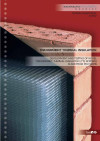Suchergebnisse
Transparent Thermal Insulation

Development and Testing of novel Transparent Thermal Insulatio (TTI) Systems made from Polymers
Forschungsforum
2/2002
Herausgeber: BMVIT
Englisch, 6 Seiten
Downloads zur Publikation
OPEN HEAT GRID - Open Heat Grids in urban hybrid systems
The primary research topic of OPEN HEAT GRID was to investigate the possibilities of enforcing the feed-in of industrial waste heat into existing district heating networks. The project results show that excess heat is not for free: despite minimal variable costs, the investment costs need to satisfy usual payback periods. The analysis shows that there is no need for a regulation in the sense of a feed-in obligation or market liberalization. However, from an economic point of view, information asymmetries exist, which may lead to irrational decisions.
Energetic building refurbishment in protection zones

Standardized solutions as a help and guideline for building-owners, authorities and companies
Film-DVD: Bauen für die Stadt der Zukunft

Dauer: 50 Minuten
Gestaltung: Claudia und Peter Giczy nach einer Idee von Michael Paula
Mehrsprachig
Refurbishment of a housing complex to passive-house standard, Graz - Dieselweg
Refurbishment of the former "Puch-Siedlung", built as a housing area for employees of the company "Puch", in Graz Liebenau, in the period from the 1950s to 1970s, as an exemplary model for a refurbishment in "passive house standard" with special thoughtfulness to the tenants. "From domestic fuel to solar self sufficiency"
Innovative regulation of thermal solar collectors
Research and development of the possibility of a "sensorless" regulation for thermal solar systems
Monitoring of multi-family houses “Tonpfeifengasse”
Evaluation of activated building parts as heat storage for renewable energy shown on the example of the multi-family houses "Tonpfeifengasse".
Conference: Smart Grids Week - Linz 2011
May 24th-27th, 2011
Power Tower, Energie AG Oberösterreich, Böhmerwaldstrasse 34021 Linz, AT
The Smart Grids Week - Linz 2011 is to contribute significantly to the development of electricity infrastructure in Austria and to continue the interconnectionprocess with international developments.
e80^3-Buildings - Sub project 2: Concept development
Based on the selection of suitable demonstration projects in Subproject 1 an innovative concept for passive and active building envelopes and energy supply of so called "Plus Energy Buildings" (renovation) has been developed.
Technical status of ventilation systems for buildings

Evaluation of existing ventilation systems in Austria considering technical quality and practicability.
LehB:klimafit! Live in existing buildings today: climate fit together
The aim of the project is to explore transferable renovation concepts for the implementation of climate-fit renovations in Vienna. Integrally optimized renovation packages will be developed, which will be optimized in the building ensembles for implementation-probable, climate-friendly overall solutions with the relevant stakeholders.
Fair: CEP® CLEAN ENERGY & PASSIVEHOUSE 2012
29. - 31. March 2012
Trade Fair Center StuttgartStuttgart, DE
International Trade Fair for Renewable Energy and Energy Efficient Buildings.
Sustainable Energy Solutions for Buildings
25. September 2014, 8:45 am - 4:00 pm
Urania, Uraniastraße 11010 Wien, AT
The aim of this jam bite event is to bring together providers and clients of innovative energy technologies to and promote new business contacts within the Alpine Space.
SB13 Graz - Sustainable Building Conference
25. - 28. September 2013
Graz University of TechnologyGraz, AT
The conference is part of a major international series of conferences that focus on sustainable building and construction.
Austrian "Building of the Future"-Project on the Philippines Receives UN-Award
The Center for Appropriate Technology (GrAT) at the Technical University of Vienna receives the international "Global Human Settlement Award" for a zero carbon building-innovation in the realm of sustainable tourism on the Philippines.
DALEC - Day- and Artificial Light with Energy Calculation
In the course of DALEC an online concept evaluation tool for architects, building engineers, lighting designers and building owners was developed. Although easy to use, the software accounts for the complex thermal and light processes in buildings and allows a simple evaluation of heating, cooling and electric lighting loads. Not only energy, but also user behavior were considered (e.g. in terms of glare protection) and visual and thermal comfort were evaluated. This novel and innovative, holistic approach makes sustainable and energy efficient building design possible for new buildings as well as refurbishment.
Programme Evaluation of "City of Tomorrow" 2013 - 2021
This evaluation examined the effects that the "City of Tomorrow" programme has achieved since its inception. The evaluation is based on extensive surveys of research project participants and various multipliers from application areas such as civil engineering and urban planning. The evaluation thereby creates an important basis for the design of future research funding.
Conference: Nearly Zero Energy Buildings
28. February - 1. March 2013
StadthalleWels, AT
The European conference to discuss how to achieve "near zero energy buildings" in new construction & renovation: technologies, policies, financial instruments, definitions & national action plans, best practice examples, cost optimality of energy efficiency and renewable energy in buildings
Conference: Smart Grids Week - Graz 2014
May 19th to 23rd, 2014
Energie Steiermark and CONGRESS GRAZGraz, AT
The Smart Grids Week - Graz 2014 aims to significantly contribute to the further development of electricity infrastructures and to link the Austrian Smart Grids activbities with the European initiatives.
Energy-Sponge-Bruck (Energieschwamm Bruck an der Mur)
The aim of the exploration-study for the urban region Bruck/Oberaich "Energieschwamm Bruck" or "Energy-Sponge-Bruck" was to establish clear and stringent basics for a flexible development of the future energy system. Therefore an energy development concept as well as a cadaster for short-term implementation measures had been applied. The structured, Bruck-based approach acts as framework for a general energy-conception-method, valid for small and medium urban regions with 10,000 to 20,000 inhabitants.
